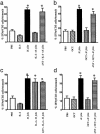Treatment of Helicobacter gastritis with IL-4 requires somatostatin
- PMID: 14555768
- PMCID: PMC240724
- DOI: 10.1073/pnas.2135193100
Treatment of Helicobacter gastritis with IL-4 requires somatostatin
Abstract
Fifty percent of the world's population is infected with Helicobacter pylori; however, treatment has been insufficient to eradicate the organisms due to rising antibiotic resistance. Helicobacter infection is characterized by induction of a T helper 1 lymphocyte (Th1) immune response, hypergastrinemia, and suppressed tissue somatostatin (SOM) levels. However, the mechanism by which the immune response regulates acid secretion is not known. We show here that treatment with IFN-gamma, a Th1 cytokine, was sufficient to induce gastritis, increase gastrin, and decrease SOM levels within 7 days. In contrast, the T helper 2 lymphocyte cytokine IL-4 increased SOM levels and effectively suppressed gastrin expression and secretion. This result demonstrated reciprocal regulation of acid regulatory peptides by immune modulators. IL-4 pretreatment prevented gastritis in infected wild-type but not in SOM null mice. Thus, the ability of IL-4 to oppose a Th1-mediated infection required SOM. Immunofluorescence was used to document the presence of IL-4 receptors on the gastric SOM-secreting cell (D cell). Moreover, IL-4 stimulated SOM release from primary D cell cultures. Treatment of mice chronically infected with Helicobacter felis for 2 mo with the SOM analogue octreotide resolved the inflammation. Thus, a mechanism by which IL-4 resolves inflammation in the stomach is by stimulating the release of SOM from gastric D cells.
Figures





References
-
- McColl, K. E., el-Omar, E., Gillen, D. & Banerjee, S. (1997) Semin. Gastrointest. Dis. 8 142-155. - PubMed
-
- el-Omar, E. M., Penman, I. D., Ardill, J. E., Chittajallu, R. S., Howie, C. & McColl, K. E. (1995) Gastroenterology 109 681-691. - PubMed
-
- Martinez, V., Curi, A. P., Torkian, B., Schaeffer, J. M., Wilkinson, H. A., Walsh, J. H. & Tache, Y. (1998) Gastroenterology 114 1125-1132. - PubMed
-
- Correa, P. (1992) Cancer Res. 52 6735-6740. - PubMed
Publication types
MeSH terms
Substances
Grants and funding
LinkOut - more resources
Full Text Sources
Medical
Molecular Biology Databases

